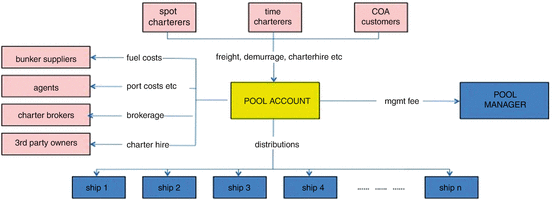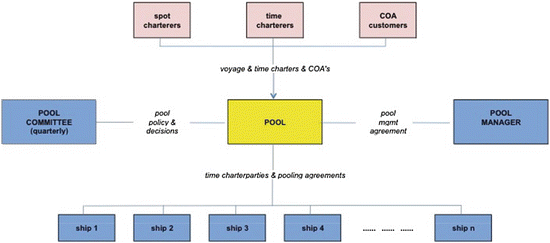Pools in International Shipping

tre
Shipping pools have come to exist in every sector of bulk and even container shipping today. No less than about 5 % of the world’s tanker fleet and about 10 % of the world’s dry bulk fleet are commercially operated in pools.
Shipping pools can be briefly described as vehicles that enable the marketing of transportation services of different owners through a single chartering entity, with the sharing of pooled income on a pre-agreed basis.
Their primary raison d’  tre from a ship-owner’s standpoint is the need to organize commercial operations purposefully, to enhance efficiency and to provide meaningful transportation services that can place an owner in a stronger bargaining position vis-à-vis charterers, thereby enhancing profitability.
tre from a ship-owner’s standpoint is the need to organize commercial operations purposefully, to enhance efficiency and to provide meaningful transportation services that can place an owner in a stronger bargaining position vis-à-vis charterers, thereby enhancing profitability.
 tre from a ship-owner’s standpoint is the need to organize commercial operations purposefully, to enhance efficiency and to provide meaningful transportation services that can place an owner in a stronger bargaining position vis-à-vis charterers, thereby enhancing profitability.
tre from a ship-owner’s standpoint is the need to organize commercial operations purposefully, to enhance efficiency and to provide meaningful transportation services that can place an owner in a stronger bargaining position vis-à-vis charterers, thereby enhancing profitability.While one might think pools are a potential threat to charterers’ market influence, charterers have by and large reacted positively to their advent. The reason for this is the increasing tendency of industrial users to focus their resources and attention on their core activities and to out-source such services as transportation. To do so with confidence, they require a strong and financially stable shipping industry, the security of adequate availability of tonnage, and a level of transportation efficiency (with attendant stable and often lower cost) as can only be available from larger, professionally-managed fleets.
Seen from the perspective of lenders, shipping pools serve as a useful proxy for period employment and therefore significantly enhance the security of a shipping credit. Though pool distributions cannot replace the security of a fixed time charter arrangement, financial benefits to the owner mentioned hereunder operate to the benefit of the bank.
15.3 Benefits to Owners
As one would expect, the combination of fleets of smaller owners into a large fleet whose commercial operation is conducted under a single umbrella provides significant benefits.
1.
The first of these is the higher visibility and market profile. This leads to a stronger customer and broker following, with resulting increase in “deal flow” and access to business that is not quoted.
2.
Closely associated with higher market profile is the perception of reliability conveyed by a larger shipping operation. A larger fleet offers end users greater confidence as to the availability of tonnage to perform a contract. The perception of reliability also stretches to professionalism of service; the inevitably larger chartering, operations and accounting staff and supporting systems found in pool operations provide that confidence. Moreover, the perception of financial reliability (although not always justified) usually accrues to the larger, professionally-managed operations.
3.
The third benefit is the ability to provide a larger range of shipping solutions, especially contracts of affreightment, to clients who are looking to outsource transportation services. There is considerable value in being able to provide transportation solutions of varying types, duration and volume on stable “industrial” terms, as opposed to simply being there to shift cargoes on an opportunistic ad hoc basis, which is all that many small owners can aspire to.
4.
The fourth benefit is the commercial advantage that results from market visibility, reliability and flexibility of service. As a minimum, a larger pool operation has more bargaining clout than the small independent owner. However, the ability to add value and to serve transportation needs on a flexible, recurring basis endears a transportation provider to its customers and fosters closer relations between the two—relations that are often strong enough to eventually replace price as the main deciding factor.
5.
Finally, but by no means least important, is the efficiency in fleet deployment that comes from being part of a larger fleet capable of providing both penetration and diversification (both geographic and functional) of markets. Ballast and waiting time is invariably reduced in a large operation with a multitude of customers, range of cargoes, contracts of affreightment and opportunity for positioning voyages. The gains in efficiency achieved by a large fleet can result in lower transportation cost to the customer while achieving higher time-charter-equivalent earnings for the owner.
15.4 Financial Impact of Pooling
As one would expect, the benefits achievable through the pooling of one’s vessels translate into tangible results:
1.
The first and most obvious result is the enhancement of earnings. The only exception to this is in a high market—or the early stages of a protracted high market—when lower-paying contracts need to be played out. However, over a complete market cycle, pools invariably produce higher earnings than the market for the reasons stated above.
2.
The second result is the reduction in the volatility of earnings that accrues from a wider range of revenue sources and of type and maturity of employment engagements.
3.
The third impact is the lower volatility of cash flows that results from participating in a larger, varied and therefore more stable aggregate stream of revenues.
4.
The diversification of risk is another result that comes from having a wide variety of revenue sources.
5.
Finally, the stable client relationships fostered by pools lead to better future earnings prospects.
The above contribute not only to direct financial results, but also to enhancing the “credit” of a participating owner.
15.5 Typical Pool Structure
Shipping pools are all, by and large, structured along very similar lines. Such a typical structure is briefly defined in this section.
Vessels are entered into a pool via a Commercial Management Agreement or Time Charter Party where the vessels are described and the responsibilities of the owner and operator are defined. In the case of Time Charters, the charter-hire is a variable amount pegged to aggregate Pool fleet earnings via weightings (Pool Points) ascribed to each Vessel (see below). These agreements are accompanied by a Pooling Agreement that sets forth the rules by which the Pool is run.
The Pool normally takes the form of a separate, single-purpose entity. It is the contracting party vis-à-vis the participating owners (Members), third-party owners of inward-chartered tonnage, and customers (Charterers). It typically does not have a staff of its own, but is managed by another (usually also single-purpose) entity, the Pool Manager.
The Pool Manager (Manager) provides services to the Pool under a Pool Management Agreement. The Manager is, more often than not, created by the founding member(s) of the Pool. The services provided by the Manager embrace chartering, operations, accounting, and reporting.
The staff of the Manager is either hired from third-party sources or seconded by participating owners. Even when run by staff of participating owners, the Manager is independent of any of the Members so as to ensure all members are treated in an even-handed manner in matters of pool point determination, off-hire and other operational matters.
Pool policy is established by the Pool Committee, and important commercial decisions are referred to it. The Pool Committee comprises representatives of all the Members. It typically convenes once a quarter. Voting power of each Member is typically pro rata according to the aggregate Pool Points of the vessels entered in the Pool by the Members.
All vessel earnings are paid into a single account (the Pool Account) in the name of the Pool and run by the Manager. As outlined below, all voyage costs and other Pool disbursements are made from this account before distributions are made to Members.
Vessels are awarded Pool Points according to objective criteria affecting earnings. These are described in the next section.
The structure of the Pool and the relationship between the above parties is depicted in Fig. 15.1.

Fig. 15.1
Pool structure